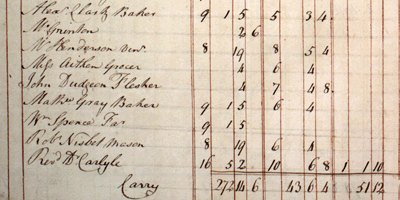Consolidated Tax Schedules for 1798-1799 available online
Consolidated Tax Schedules for 1798-1799 available online

National Records of Scotland are pleased to announce that we have made the Consolidated Tax Schedules for 1798-1799 available online via the ScotlandsPlaces website.
In the late-eighteenth century the government of William Pitt the Younger had introduced many individual taxes, including taxes on houses, windows, servants, carriages, carts, horses and dogs. From 1798 onwards the way taxpayers were assessed for these taxes changed, and schedules were drawn up which listed all the taxes due by each taxpayer (NRS reference E326/15).
The surviving rolls for the 27 counties contain details on about 80,000 taxpayers.
These consolidated schedules survive for 1798 to 1799, but only for counties which begin with the letters A-M (so no schedules survive for Nairnshire, Orkney, Peebles-shire, Perthshire, Renfrewshire, Ross-shire and Wigtownshire).
Access to the Consolidated Tax Schedules on the ScotlandsPlaces site requires a subscription, but the images can be browsed as ‘Virtual Volumes’ in the Historical Search Room at the National Records of Scotland in Edinburgh (free of charge) and in the ScotlandsPeople Centre. They are not yet indexed.
In the example below (E326/15/20 page 150), the Reverend Dr Alexander Carlyle, friend of David Hume and Adam Smith, is listed as one of the people in Inveresk parish liable for the tax. The schedule reveals that he had to pay, amongst others, for 16 windows, 1 male servant, 1 carriage and two horses.
